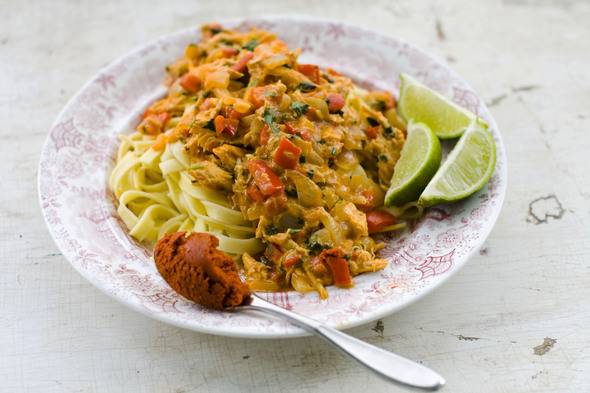Red curry paste: What it is and how to use it

Red curry chicken noodles are seen in this photo taken Monday, July 25, 2011 in Concord, NH.
AP Photo | Matthew Mead
It's red, but it isn't red hot. And that's why it's the sort of curry the average American is going to love.
I'm talking about red curry paste, one of a literal rainbow of intensely flavorful Southeast Asian seasonings.
To be clear, curry pastes are not the same as the curry powders most people know, though they do share some ingredients.
Curry pastes — which are used in Thai, Indonesian, Malaysian and Indian cooking — combine dry spices with ground fresh herbs and roots, garlic, chilies and other ingredients to form thick pastes.
These pastes often are classified by color. Green curry paste, for example, is a fiery Thai blend that combines green chilies, lemon grass, garlic, shrimp paste and kaffir lime leaves. It usually is blended with coconut milk to season beef, pork and chicken.
Yellow curry paste is a bit milder and usually sports garlic, lemon grass, galangal (a relative of ginger), cumin, cinnamon and turmeric. It's popular for adding to soups.
But the most versatile and widely used is red curry paste, a mash of red chilies, coriander roots and leaves, shrimp paste, lemon grass, garlic, shallots and galangal.
It's got some kick, but it won't sear your mouth. It's used with everything from chicken, duck and beef to pork and shrimp. And it lands in everything from stews, curries and soups to dressings, marinades and condiments.
The smell is both comfortingly tomatoey and exotically heady with spicy aromas. The flavor is warm, but not biting, with tastes of ginger and garlic.
Conveniently, red curry paste also is the easiest variety to find at the typical American grocer. It usually is packed in small glass jars or cans and can be found in the Asian section. Once opened, the remainder can be refrigerated for months.
I like to combine red curry paste with the meat from a rotisserie chicken and a package of fresh pasta for an easy and incredibly delicious weeknight dinner. For more ideas for using red curry paste, check out the Off the Beaten Aisle column over on Food Network: http://bit.ly/Hfg2Jm
___
RED CURRY CHICKEN NOODLES
Not in the mood for noodles? The curried chicken mixture also makes a killer sandwich, both warm and cold.
Start to finish: 20 minutes
Servings: 4
12-ounce package fresh fettuccine pasta
1 tablespoon olive oil
1 large yellow onion, diced
1 red bell pepper, cored and diced
14-ounce can coconut milk
1 1/2 to 2 1/2 tablespoons red curry paste (more or less to taste)
Meat from a 1 1/2-pound rotisserie chicken
1/3 cup chopped fresh cilantro
1 lime, quartered
Bring a large saucepan of salted water to a boil. Add the pasta and cook according to package directions. Drain and set aside.
Meanwhile, in a large saute pan over medium-high, heat the olive oil. Add the onion and bell pepper, then saute until tender, about 10 minutes. Add the coconut milk and red curry paste. Stir until the curry paste and coconut milk are smooth, then bring to a simmer.
Chop or pull the chicken meat into bite-size chunks, then add to the coconut milk mixture. Toss well to coat evenly. If the meat is cold, return to a simmer. Stir in the cilantro.
Serve the pasta topped with the chicken. Alternatively, add the drained pasta to the pan with the chicken and toss to mix. Just before serving, squeeze a bit of lime juice over each plate.
Nutrition information per serving (values are rounded to the nearest whole number): 610 calories; 260 calories from fat (43 percent of total calories); 29 g fat (20 g saturated; 0 g trans fats); 120 mg cholesterol; 57 g carbohydrate; 30 g protein; 6 g fiber; 390 mg sodium.
___
J.M. Hirsch is the national food editor for The Associated Press. He is author of the recent cookbook, "High Flavor, Low Labor: Reinventing Weeknight Cooking." His Off the Beaten Aisle column also appears at FoodNetwork.com. Follow him on Twitter http://twitter.com/JM_Hirsch.

